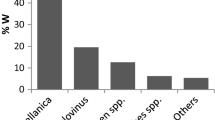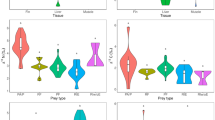Abstract
Stable isotopes of nitrogen and carbon (δ15N and δ13C) provide an important tool to examine diet, trophic position and movement/migration of both aquatic and terrestrial animals. Over the past 10 years, there have been repeated calls to tighten up basic assumptions when applying stable isotopes, one of the most important being the application of accurate, species-specific diet-tissue discrimination factors (DTDFs). Taxa- or species-specific DTDFs are required for (i) predicting dietary sources to a consumer using stable isotope mixing models and (ii) for estimating trophic position relative to primary consumers or known base species. Logan & Lutcavage (2010) recently presented data on stable isotope dynamics in elasmobranch fishes and concluded that DTDFs for teleost fish were suitable for elasmobranch fish, endorsing the generally applied value of 3.4‰. When considering (i) a recent study which found that DTDFs were lower for large sharks than teleost fish (Hussey et al., 2010) and (ii) that the Logan and Lutcavage study did not experimentally address the issue of DTDFs, we would argue that this conclusion is misleading. We demonstrate this point by estimating the proportion of prey items of a captive shark with a known diet history by modelling the δ15N values of the shark and its prey. The often repeated implication of inaccurate DTDFs is clear, with model results highly variable depending on the selected DTDF. In addition, model results for the standard teleost DTDF of 3.4‰ provided erroneous estimates of prey consumption. The suggestion that DTDFs for teleost fish are suitable for elasmobranchs may mislead investigators to choose DTDFs which are likely not applicable to their study species. Caution is therefore warranted in advocating this approach. Continued experimental work to examine stable isotopes in sharks is required and recommendations are made.

Similar content being viewed by others
References
Ben-David, M. & D. M. Schell, 2001. Mixing models in analysis of diet using multiple stable isotopes: a response. Oecologia 127: 180–184.
Caut, S., A. Elena & C. Franck, 2008. Caution on isotopic model use for analyses of consumer diet. Canadian Journal of Zoology 86: 438–445.
Caut, S., E. Angulo & F. Courchamp, 2009. Variation in discrimination factors (Δ15N and Δ13C): the effect of diet isotopic values and applications for diet reconstruction. Journal of Applied Ecology 46: 443–453.
Estrada, J. A., A. N. Rice, M. E. Lutcavage & G. B. Skomal, 2003. Predicting trophic position in sharks of the north-west Atlantic Ocean using stable isotopes. Journal of the Marine Biological Association of the United Kingdom 83: 1347–1350.
Felicetti, L. A., C. C. Schwartz, R. O. Rye, M. A. Haroldson, K. A. Gunther, D. L. Phillips & C. T. Robbins, 2003. Use of sulphur and nitrogen isotopes to determine the importance of whitebark pine nuts to Yellowstone grizzly bears. Canadian Journal of Zoology 81: 763–770.
Fisk, A. T., S. A. Tittlemier, J. L. Pranschke & R. J. Norstrom, 2002. Using anthropogenic contaminants and stable isotopes to assess the feeding ecology of Greenland shark. Ecology 83: 2162–2172.
Gannes, L. Z., D. O’Brien & C. Martinez del Rio, 1997. Stable isotopes in animal ecology: assumptions, caveats and a call for laboratory experiments. Ecology 78: 1271–1276.
Hussey, N. E., J. Brush, I. D. McCarthy & A. T. Fisk, 2010. δ15N and δ13C diet discrimination factors for large sharks under semi-controlled conditions. Comparative Biochemistry and Physiology Part A 155: 445–453.
Jardine, T. D., K. A. Kidd & A. T. Fisk, 2006. Applications, considerations and sources of uncertainty when using stable isotope analysis in ecotoxicology. Environmental Science and Technology 40: 7501–7511.
Logan, J. M. & M. E. Lutcavage, 2010. Stable isotope dynamics in elasmobranch fishes. Hydrobiologia 644: 231–244.
MacNeil, M. A., K. G. Drouillard & A. T. Fisk, 2006. Variable uptake and elimination of stable nitrogen isotopes between tissues in fish. Canadian Journal of Fisheries and Aquatic Sciences 63: 345–353.
Martinez del Rio, C., N. Wolf, S. A. Carleton & L. Z. Gannes, 2009. Isotopic ecology ten years after a call for more laboratory experiments. Biological Reviews 84: 91–111.
Moore, J. W. & B. X. Semmens, 2008. Incorporating uncertainty and prior information in stable isotope mixing models. Ecology Letters 11: 470–480.
Overmyer, J. O., M. A. MacNeil & A. T. Fisk, 2008. Fractionation and metabolic turnover of carbon and nitrogen stable isotopes in black fly larvae. Rapid Communications in Mass Spectrometry 22: 694–700.
Phillips, D. L. & J. W. Gregg, 2003. Source portioning using stable isotopes: coping with too many sources. Oecologia 136: 261–269.
Pinnegar, J. K. & N. V. C. Polunin, 1999. Differential fractionation of δ13C and δ15N among fish tissues: implications for the study of trophic interactions. Functional Ecology 13: 225–231.
Post, D. M., 2002. Using stable isotopes to estimate trophic position: models, methods, and assumptions. Ecology 83: 703–718.
Robbins, C. T., L. A. Felicetti & M. Sponheimer, 2005. The effects of dietary protein quality on nitrogen isotope discrimination in mammals and birds. Oecologia 144: 534–540.
Trueman, C. N., R. A. R. McGill & P. H. Guyard, 2005. The effect of growth rate on tissue-diet isotopic spacing in rapidly growing animals. An experimental study with Atlantic salmon (Salmo salar). Rapid Communications in Mass Spectrometry 19: 3239–3247.
Vanderklift, M. A. & S. Ponsard, 2003. Sources of variation in consumer-diet δ15N enrichment: a meta-analysis. Oecologia 136: 169–182.
Wolf, N., S. A. Carleton & C. Martinez del Rio, 2009. Ten years of experimental animal isotopic ecology. Functional Ecology 23: 17–26.
Author information
Authors and Affiliations
Corresponding author
Additional information
Handling editor: I. Nagelkerken
Rights and permissions
About this article
Cite this article
Hussey, N.E., MacNeil, M.A. & Fisk, A.T. The requirement for accurate diet-tissue discrimination factors for interpreting stable isotopes in sharks. Hydrobiologia 654, 1–5 (2010). https://doi.org/10.1007/s10750-010-0361-1
Received:
Revised:
Accepted:
Published:
Issue Date:
DOI: https://doi.org/10.1007/s10750-010-0361-1




